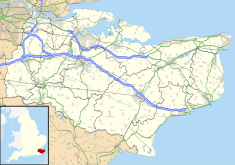
The Isle of Sheppey is an island off the northern coast of Kent, England, neighbouring the Thames Estuary, centred 42 miles (68 km) from central London. It has an area of 36 square miles (93 km2). The island forms part of the local government district of Swale. Sheppey is derived from Old English Sceapig, meaning "Sheep Island".
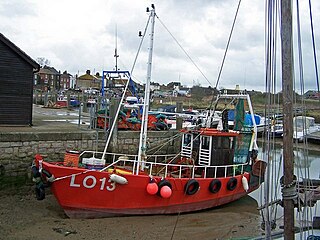
Queenborough is a town on the Isle of Sheppey in the Swale borough of Kent in South East England.
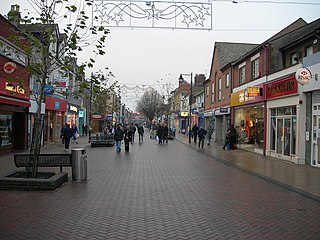
Gillingham is a large town in the unitary authority area of Medway in the ceremonial county of Kent, England. The town forms a conurbation with neighbouring towns Chatham, Rochester, Strood and Rainham. It is also the largest town in the borough of Medway.

Swale is a local government district with borough status in Kent, England and is bounded by Medway to the west, Canterbury to the east, Ashford to the south and Maidstone to the south west. Its council is based in Sittingbourne. The district is named after the narrow channel called The Swale, that separates the mainland of Kent from the Isle of Sheppey, and which occupies the central part of the district.

Faversham is a market town in Kent, England, 8 miles (13 km) from Sittingbourne, 48 miles (77 km) from London and 10 miles (16 km) from Canterbury, next to the Swale, a strip of sea separating mainland Kent from the Isle of Sheppey in the Thames Estuary. It is close to the A2, which follows an ancient British trackway which was used by the Romans and the Anglo-Saxons, and known as Watling Street. The name is of Old English origin, meaning "the metal-worker's village".

Sheerness is a port town and civil parish beside the mouth of the River Medway on the north-west corner of the Isle of Sheppey in north Kent, England. With a population of 11,938, it is the second largest town on the island after the nearby town of Minster which has a population of 21,319.
The constituency of Queenborough was a rotten borough situated on the Isle of Sheppey in Kent.
Queenborough-in-Sheppey was a municipal borough in Kent, England from 1968 to 1974. It was created by a merger of the Municipal Borough of Queenborough with Sheerness Urban District and Sheppey Rural District, and occupied the entire Isle of Sheppey. It incorporated the following parishes:

Queenborough Castle, also known as Sheppey Castle, is a 14th-century castle, the remnants of which are in the town of Queenborough on the Isle of Sheppey, Kent in England. The castle and the associated planned town were built on the orders of King Edward III from 1361 and named in honour his wife, Queen Philippa. It was the first concentric castle to be built in England, and the only royal castle to be new-built in England during the Late Middle Ages. Overlooking the Swale, then an important waterway approaching the River Medway, Queenborough Castle formed part of the country's coastal defences until 1650 when it was declared to be unfit for use and was almost completely demolished shortly afterwards. The site is now a public park and the only visible remains are some low earthworks.

Halfway Houses is a village on the Isle of Sheppey in the Swale borough of Kent in England. It derives its name from the pub in the village centre, with the same name, which was so named because it is halfway between Minster and Sheerness, before the coastal road was built along the north coast connecting Minster and Sheerness. It is bordered to the west by the town of Queenborough and the village of Minster-on-Sea, and to the east by the town of Minster. It is one mile south of the town of Sheerness. It is in the Queenborough and Halfway ward of Swale Borough Council.
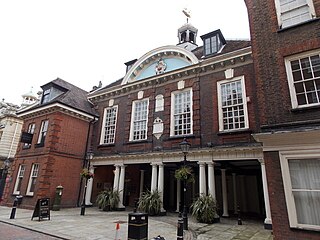
The Rochester Guildhall is an historic building located in the High Street in Rochester, Kent, England. It is a Grade I listed building.

The 2007 Swale Borough Council election took place on 3 May 2007 to elect members of Swale Borough Council in Kent, England. One third of the council was up for election and the Conservative Party stayed in overall control of the council.

The 2010 Swale Borough Council election took place on 6 May 2010 to elect members of Swale Borough Council in Kent, England. One third of the council was up for election and the Conservative Party stayed in overall control of the council.
Elections were held to Swale Borough Council in England as part of the United Kingdom local elections on 2 May 2019.
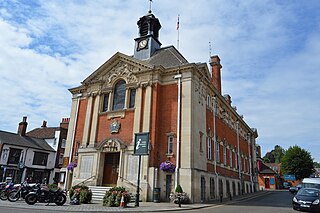
Henley Town Hall is a municipal structure in the Market Place in Henley-on-Thames, Oxfordshire, England. The town hall, which is the headquarters of Henley Town Council, is a Grade II* listed building.
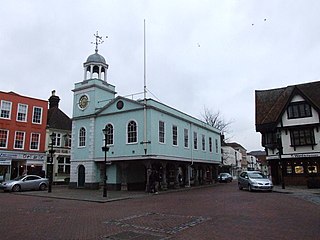
Faversham Guildhall is a municipal building in the Market Place in Faversham, Kent, England. The structure, which was the meeting place of Faversham Borough Council, is a Grade II* listed building.
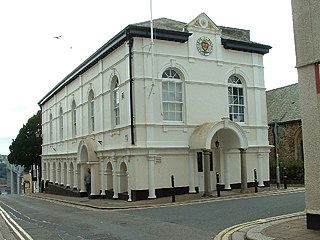
Saltash Guildhall is a municipal building in Fore Street, Saltash, Cornwall, England. The structure, which was the meeting place of Saltash Borough Council, is a Grade II listed building.

Lostwithiel Guildhall is a municipal building in Fore Street in Lostwithiel, Cornwall, England. The structure, which currently accommodates the local museum, is a Grade II listed building.

The Old Guildhall is a municipal building in Higher Market Street in Looe, Cornwall, England. The structure, which is currently used as a museum, is a Grade II* listed building.

Lydd Guildhall, also known as Lydd Town Hall and the Lydd Common House, is a municipal building in the High Street, Lydd, Kent, England. The structure, which accommodates the offices and meeting place of Lydd Town Council, is a Grade II listed building.

